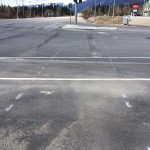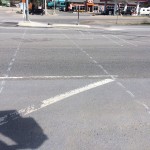By: Korie Marshall
Lakes District Maintenance Ltd, local highways maintenance contractor for the Robson Valley, held their annual stakeholders meeting on April 15th at their Tete Jaune office.
Representatives from Commercial Vehicle Safety Enforcement, RCMP, Ministry of Transportation and Infrastructure, Valemount Council and staff, Regional District Board of Directors, Valemount Community Forest, Mount Robson and Jasper Parks and local contractors joined LDM staff for the update on winter operations, plans for the summer and some discussions.
John Traquair, LDM Operations Manager for the Robson area said the generally mild winter, punctuated by a few heavy snowfalls, meant they used less traction material on the roads this year, and they are pleased with the performance of the new brine plant and trucks. He says the snowfalls this winter of 110 cm at once seem like “just another day” in this area, whereas 40 cm would close a city like Kamloops.
Traquair says LDM hasn’t had to deal with an avalanche in the area this year, the first time in the years since they took on the contract for maintenance of this area, and avalanches had not been common in the years previous. He noted the change to the highway classification mid-winter last year did not affect the south and west areas of their region (Highway 5 and Highway 16 from Tete Jaune to the Alberta border) but Highway 16 from Tete Jaune west to Prince George was affected.
“It is a benefit to the North,” said Greg Bruce, representative of the Ministry, about the upgrade to classification for a number of northern highway sections. He noted that all the maintenance contractors in the north deserve recognition for rising to the challenge to provide the additional maintenance last year, but LDM did especially well and had the capacity to transition quickly.
Rod Saul, LDM’s planning and quality assurance manager, reviewed some of the projects planned for this summer, including paving four new chain-up and chain-off pullouts at the Goat and West Twin as well as paving the chain-off on the north side at Messiter (south of Blue River); a focus on brushing side roads; and crack sealing (shoulder to shoulder) from Cedarside to the Tete Jaune junction which may cause traffic delays for about a week. The Village of Valemount is also coordinating with the same crack sealing company to seal the airport, which should save the Village money on transportation cost for the equipment and crew. All three highway sections from Blue River to McBride will also be spray patched.
Bruce noted the new information sign in Tete Jaune, for traffic coming from the Alberta border, is not hooked up to Telus internet yet. It currently gives a generic safety message, but will be connected soon and will be controlled by the Regional Transportation Management Centre. It will offer the ability for the RCMP as well as ministry staff to post information about closures and incidents on both Highway 5 south towards Kamloops and Highway 15 west towards Prince George. When connected, it will show the worst conditions on the highway between Tete Jaune and the next information sign, so it’s important to remember those conditions might not be the case immediately, says Bruce. It’s important to check Drive BC for fuller information.
Bruce says the ministry is also working on continued repairs at the “slip” in the highway just south of McBride, and line painters are booked for the region. The old crosswalk markings at the new lights at Highway 5 and 5th Avenue in Valemount have been removed and will be repainted with better alignment when the painters arrive.
Sergeant Darren Woroshelo noted there is still confusion coming from Pine Road and the Shell station because it looks like there is room for a left turning lane, but that is not where the sensor to trip the lights is placed.
Traquair read an update from ICBC, new this year. The report says that vehicle thefts and break-ins province wide were up in 2014 over the previous year, but Sergeant Woroshelo says they are actually down locally, and targeting aggressive driving will be a focus of the RCMP and ICBC in May.
There was also some discussion about social media, including Facebook groups like Hwy Conditions for Robson Valley/Thompson Valley and Area, where people share local highway conditions and photos. Traquair says people seem to be using Facebook even more than DriveBC. Bruce shared a story about how the severity of a mudslide got distorted until someone shared a photo of the slide on social media. Almost immediately people could see that the slide wasn’t as severe as the comments had made it out to be. But in another case, someone was posting on Twitter about road closures in an area, many of which turned out to be false. The ministry had to have someone continually monitor Twitter and either verify the closures with staff on the ground in the area, or counter the posts with correct information. Bruce says that while social media can be valuable, he still recommends checking out DriveBC for the most accurate information.






